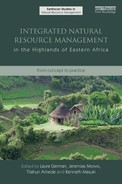ACKNOWLEDGMENTS
Many people and organizations contributed to the work of AHI in the decade of work profiled in this volume and in the effort to compile it, and it would be an impossible task to list them all. The authors would like to recognize, first and foremost, the commitment of the farmers of the humid highlands of eastern Africa whose enthusiasm, dedication, and patience enabled the program to engage in a host of previously untested innovations in order to accomplish its mandate. The dedication of AHI site teams and their courage to explore the unknown were key factors in the success the program has achieved, for which AHI staff, partners, and donors are grateful. Without the leadership and support of the managers of national agricultural research institutes (NARIs) in Ethiopia, Kenya, Madagascar, Rwanda, Tanzania, and Uganda, this work would not have been successful; we bank on their continued support as we move into the next decade. Other partners who served instrumental roles in the evolution of AHI include sister CGIAR programs and centers (CAPRi, CIAT, ICRAF, IFPRI, ILRI, CIMMYT, CIP, and ICRISAT); non-governmental organizations (CARE International—Uganda, Africare, Africa 2000 Network, Action Aid, Farm Africa, and SOS-Sahel); the National Agricultural Advisory Services of Uganda (NAADS); extension organizations in AHI benchmark sites; the Kapchorwa District Landcare Chapter (KADLACC); and a host of farmers’ organizations in AHI benchmark sites.
The ability of AHI to sustain innovation and learning over more than a decade is in large part attributable to the generous financial support AHI has received from a few committed donors who have shown total commitment to the piloting of new forms of professionalism and its potential to unlock change in rural livelihoods and environmental management—namely, the Swiss Development Cooperation (SDC); the International Development Research Centre (IDRC); the European Commission; Cooperazione Italiana; and the Ministerie van Buitenlandse Zaken (the Netherlands). We are also grateful to other donors who funded AHI for specific initiatives that have gone a long way in furthering our learning on topics of instrumental importance to the program and the region. Among these donors, we would like to acknowledge the Collective Action and Property Rights program of the CGIAR (CAPRi); the Department for International Development (UK); Aus-AID (Australia); the Rockefeller Foundation; and the Norwegian government.
A number of individuals provided periodic mentoring and facilitation to support the conceptualization of the AHI approach over the years. While many individuals have made significant contributions in this regard, Jürgen Hagmann and Rajiv Khandelwal deserve special mention. We would also like to acknowledge the support of those who have helped to usher us through the publication process. Those deserving special mention include Dina Hubudin at CIFOR for her patient assistance in formatting the manuscript to Earthscan style guides, Paul Stapleton and Rose Onyango at ICRAF for facilitating various communications with Earthscan, and Tim Hardwick and Ashley Irons at Earthscan, and Bill Carman of IDRC who patiently guided the book to its completion.
We are also grateful to our institutional hosts, ASARECA and ICRAF, for their technical, financial and administrative support to AHI activities and guidance during times of transition. We give special thanks to Dr. Seyfu Ketema, Dr. Denis Garrity, Dr. Eldad Tukahirwa, Dr. Jan Laarman, Dr. Mohamed Bakarr, and the ICRAF finance and human resource departments. We would like to also express our sincere appreciation to Dr. Roger Kirkby, who assisted in steering AHI through a challenging transition away from Dr. Ann Stroud's competent leadership.
And last but not least, we would like to acknowledge the intellectual guidance and commitment of the late Dr. Luis Navarro. From the very beginning, Luis was much more than a donor to AHI – participating in steering committee meetings, engaging in regular dialogue to shape the program's vision and evolution, and challenging the AHI team to step beyond conventional boundaries. We are most grateful for the creative tensions inspired by your mentorship.
